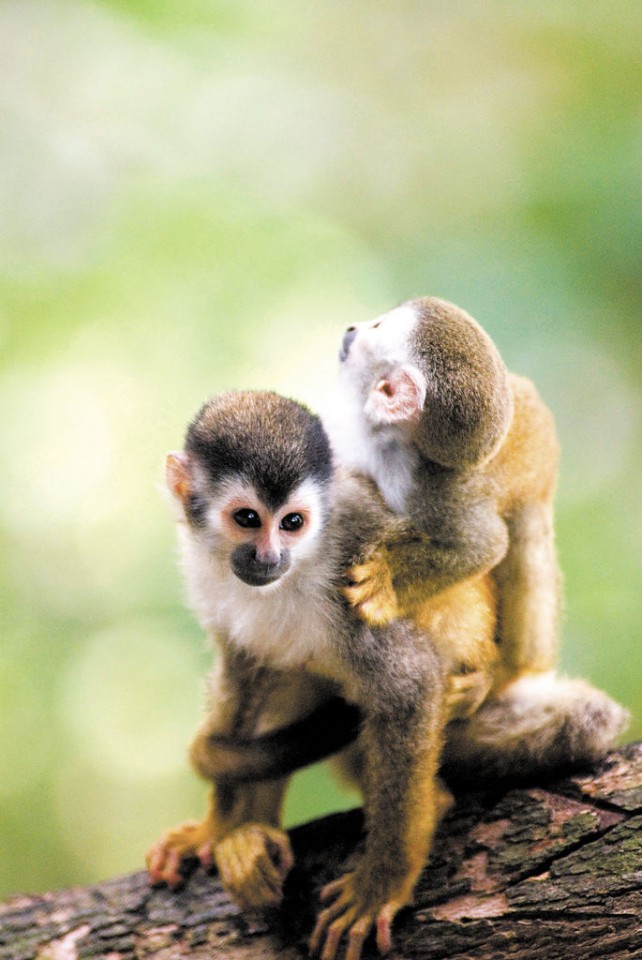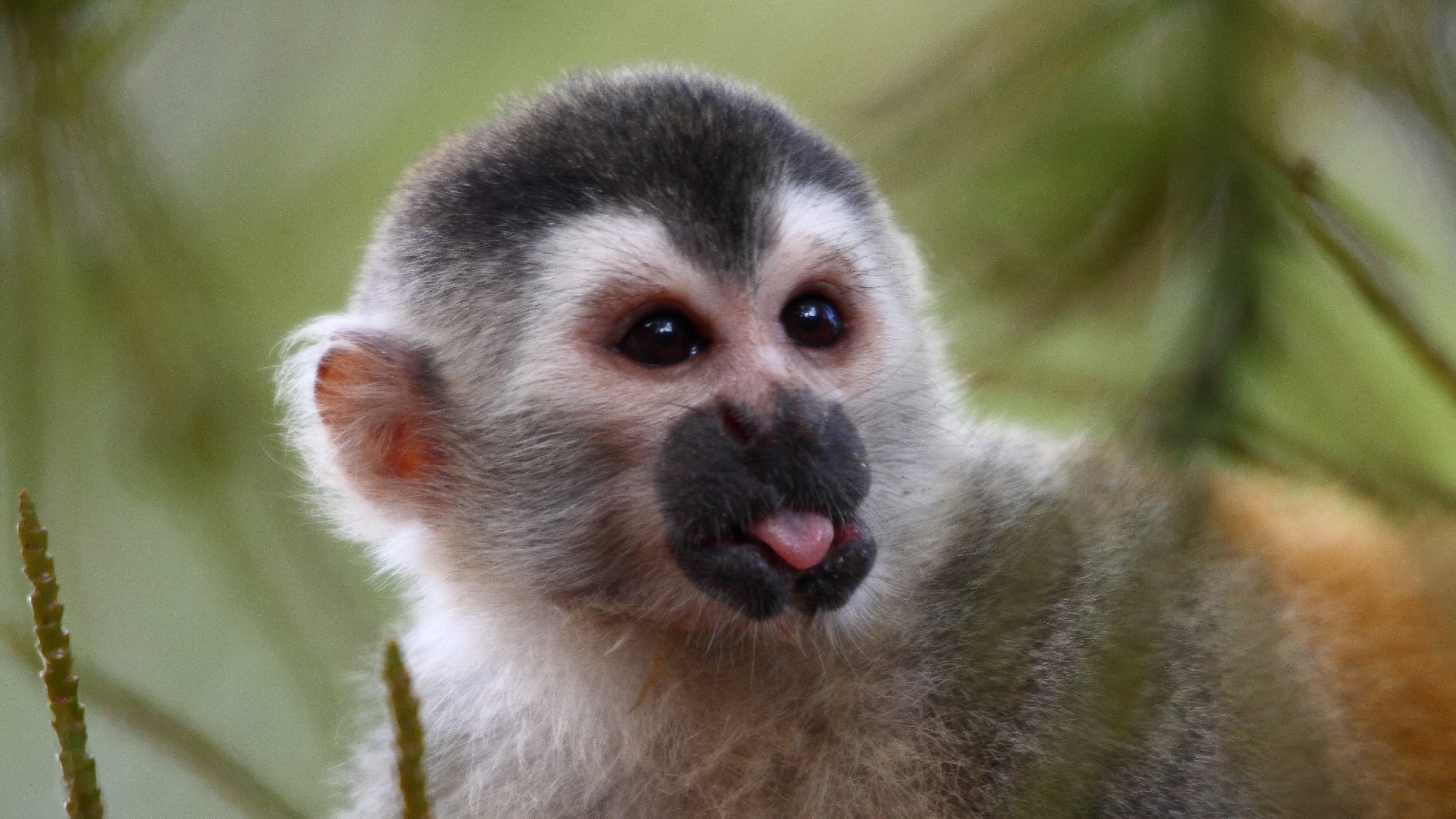Grey Crowned Central American Squirrel Monkey
Mono Tití
The mono tití, or the grey crowned red-backed squirrel monkey (Saimiri oerstedii citrinellus), is the smallest primate in Costa Rica. This subspecies is only found in and around Quepos/Manuel Antonio National Park on the Central Pacific Coast of Costa Rica. They have been listed as Critically Endangered by IUCN Red List since 1996; and Endangered in 2008.
The Mono Titi as an Indicator of Environmental Degradation of Costa Rica’s Central Pacific Region
According to a study in 2006 by the University of Florida anthropologist Sue Boinski, approximately 1,500 individuals of this subspecies and 4,000 individuals of the species on the whole, remained in the area at that time. That’s down from a population estimated at 200,000 in 1983! Urgent action must be taken to save this beautiful monkey.
The conservation status of the grey-crowned squirrel monkey Saimiri oerstedi citrinellus was last assessed in 2008, at which time the subspecies was listed as Endangered due to its small range (~3,500 km² extent of occurrence), severe fragmentation, and continuing loss of habitat. The national primate experts believe there are 2.000 individuals, all in the Central Pacific area of Costa Rica. The other subspeciesSaimiri oerstedii oerstedii, whose habitat extends to Central America, is currently listed as vulnerable by the IUCN Red List.
The squirrel monkeys’ fall from a status of Critically Endangered to Endangered is a positive sign, displaying the real, tangible results of research and conservation efforts already in place. Now, it is up to us all to continue this work, and ensure the titis’ continued rise out of the danger of extinction.
At the Titi Conservation Alliance, we promise to continue to preserve and protect this peaceful primate. We hope that you will join us in this fight.
DETAILED INFORMATION
Infraorder: Simiiformes
Family: Cebidae
Subfamily: Saimiriinae
Genus: Saimiri
Species: S. boliviensis, S. oerstedti, S. sciureus, S. ustus, S. vanzolinii
Subspecies: S. b. boliviensis, S. b. peruviensis, S. o. citrinellus, S. o. oerstedti, S. s. albigena, S. s. cassiquiarensis, S. s. macrodon, S. s. sciureus
 Even though there are slight morphological differences among squirrel monkey species, all have the same general facial and body colorations and are easily distinguished as part of the genus. Squirrel monkeys have white masks of fur around their eyes and dark brown or black coloration around the mouth and chin. Species are separated by the shape of the arch of white fur over their eyes, and are either characterized as having a “roman” or “gothic” arch (Rowe 1996; Groves 2001). The species in the Saimiri sciureus group have a “gothic” arch in which the white fur is dramatically high and the darker fur on their heads forms a deep “V” shape between their eyes. S. boliviensis and S. vanzolinii are categorized in the Saimiri boliviensis group and have a “roman” arch of fur which is more rounded than the “gothic” type and does not extend as far up onto the forehead. The gray or black fur on their head makes a very shallow “V” pattern between their eyes (Groves 2001).
Even though there are slight morphological differences among squirrel monkey species, all have the same general facial and body colorations and are easily distinguished as part of the genus. Squirrel monkeys have white masks of fur around their eyes and dark brown or black coloration around the mouth and chin. Species are separated by the shape of the arch of white fur over their eyes, and are either characterized as having a “roman” or “gothic” arch (Rowe 1996; Groves 2001). The species in the Saimiri sciureus group have a “gothic” arch in which the white fur is dramatically high and the darker fur on their heads forms a deep “V” shape between their eyes. S. boliviensis and S. vanzolinii are categorized in the Saimiri boliviensis group and have a “roman” arch of fur which is more rounded than the “gothic” type and does not extend as far up onto the forehead. The gray or black fur on their head makes a very shallow “V” pattern between their eyes (Groves 2001). Squirrel monkeys are found primarily in tropical lowland rainforest throughout the Amazon basin from Paraguay to Guyana and in Costa Rica and Panama. Squirrel monkeys are habitat generalists and have few restrictive requirements in regard to forest type compared to other neotropical primate; they can survive in a myriad of habitat types, including disturbed and edge forests (Kinzey 1997; Kauffman pers. comm.). Across their range, squirrel monkeys are found in similar habitat types ranging from undisturbed tropical and evergreen primary forests, selectively logged tropical forests, secondary growth tropical forests, and disturbed or edge forests (Boinski 1987b; Rowe 1996; Kinzey 1997; Boinski 1999; Boinski et al. 2002). There is marked seasonality in most of these ecosystems, with the dry season lasting from approximately January to March and the rainy season from April to December with coinciding periods of fruit and flower abundance (Boinski 1987b).
Squirrel monkeys are found primarily in tropical lowland rainforest throughout the Amazon basin from Paraguay to Guyana and in Costa Rica and Panama. Squirrel monkeys are habitat generalists and have few restrictive requirements in regard to forest type compared to other neotropical primate; they can survive in a myriad of habitat types, including disturbed and edge forests (Kinzey 1997; Kauffman pers. comm.). Across their range, squirrel monkeys are found in similar habitat types ranging from undisturbed tropical and evergreen primary forests, selectively logged tropical forests, secondary growth tropical forests, and disturbed or edge forests (Boinski 1987b; Rowe 1996; Kinzey 1997; Boinski 1999; Boinski et al. 2002). There is marked seasonality in most of these ecosystems, with the dry season lasting from approximately January to March and the rainy season from April to December with coinciding periods of fruit and flower abundance (Boinski 1987b). Though they are geographically widespread, squirrel monkeys exhibit very little difference in ecological behavior because the habitats in which they are found are quite similar (Boinski 1999; Boinski et al. 2002). Squirrel monkeys are insectivores-frugivores, consuming insects and fruit in their diet, depending on seasonal abundance of each resource, and supplementing their diets with small vertebrates, nectar, flowers, buds, seeds, leaves, and gum (Boinski & Timm 1985; Kinzey 1997; Boinski 1999). Squirrel monkeys rarely go after insects that are in motion and prefer to capture stationary insects on plant surfaces. They hunt for insects on the surface of live leaves or by unfolding leaf curls of dead foliage and prefer caterpillars and grasshoppers over other insects (Boinski 1988; Janson & Boinski 1992).Saimiri preferentially ingest small, soft, berry-like fruits less than one centimeter in diameter found in the lower and middle canopies of the forest (Janson & Boinski 1992; Kinzey 1997). The small vertebrates consumed include bats, which they systematically search for in large stands of trees, small birds, and bird eggs (Janson & Boinski 1992). During the year, the period of greatest food abundance is between April and June (Boinski 1988).
Though they are geographically widespread, squirrel monkeys exhibit very little difference in ecological behavior because the habitats in which they are found are quite similar (Boinski 1999; Boinski et al. 2002). Squirrel monkeys are insectivores-frugivores, consuming insects and fruit in their diet, depending on seasonal abundance of each resource, and supplementing their diets with small vertebrates, nectar, flowers, buds, seeds, leaves, and gum (Boinski & Timm 1985; Kinzey 1997; Boinski 1999). Squirrel monkeys rarely go after insects that are in motion and prefer to capture stationary insects on plant surfaces. They hunt for insects on the surface of live leaves or by unfolding leaf curls of dead foliage and prefer caterpillars and grasshoppers over other insects (Boinski 1988; Janson & Boinski 1992).Saimiri preferentially ingest small, soft, berry-like fruits less than one centimeter in diameter found in the lower and middle canopies of the forest (Janson & Boinski 1992; Kinzey 1997). The small vertebrates consumed include bats, which they systematically search for in large stands of trees, small birds, and bird eggs (Janson & Boinski 1992). During the year, the period of greatest food abundance is between April and June (Boinski 1988).The social organization of S. boliviensis at Manu National Park, Peru is markedly different from that seen in S. oerstedti. In Peru, squirrel monkeys live in multi-male/multi-female groups of 45 to 75 individuals in which males emigrate from their natal groups at sexual maturity and females remain in their natal groups throughout their lives (Mitchell 1994). Both sexes have independent dominance hierarchies, but females within this species are behaviorally dominant over all males within the group. Females often spatially segregate males to the periphery of the group through aggressive interactions, and exhibit aggressive behavior to other females except when interacting with their relatives. Males within the group, on the other hand, are not related but are extremely aggressive towards one another, especially during the mating season when they compete for mates (Mitchell 1994). When males disperse from their natal groups they form all-male bands, or coalitions, in order to immigrate into a new group and begin breeding (Mitchell 1994; Boinski 1999; Boinski et al. 2005). Members of these bachelor groups are usually members of the same age class and they work together to take over the highest positions in their new groups’ dominance hierarchy. These alliances remain strong if the males remain in the same group as is evidenced by cooperative aggression toward immigrating males. Males may move in and out of several groups over their lifetimes (Mitchell 1994).
 Squirrel monkeys have a polygamous mating system, but usually one or two males copulate the most frequently of any in the group (Boinski 1987a). Females reach sexual maturity around 2.5 years of age and males are sexually mature at 3.5 years.
Squirrel monkeys have a polygamous mating system, but usually one or two males copulate the most frequently of any in the group (Boinski 1987a). Females reach sexual maturity around 2.5 years of age and males are sexually mature at 3.5 years.
Females prefer the sexually mature males that gain the most weight during the two months prior to the breeding season, which lasts from early August to early October. The first signs of “fatting” among males are seen in June (Boinski 1987a). While the largest males monopolize the majority of copulations, young females in their first or second breeding seasons are not as selective as experienced females and will mate with other sexually mature males who may not be as large (Boinski 1987a). In order to determine sexual receptivity, groups of males, usually related because of dispersal patterns among S. oerstedti, chase and grab a female, holding her down to inspect her genitalia. Presumably the males are using olfactorycues to determine her reproductive state because they remain nearby until the female shows interest in the largest males (Boinski 1987a). Gestation lasts 145 days and the birth season lasts from February to early April. This is the dry season and period of highest arthropod abundance (Boinski 1987c). All squirrel monkeys exhibit birth synchrony to decrease chances of predation, though S. oerstedti and S. sciureus exhibit more intense synchrony than S. boliviensis. All of the pregnant females in S. oerstedti groups give birth within two weeks of each other while pregnant S. sciureus females give birth within less than a week. This concentration is much higher than S. boliviensis, who give birth within the same two months (Boinski 1987c; 1999). Most S. oerstedti females give birth every year while S. boliviensis give birth every other year (Kinzey 1997).
 One of the most widely recognized postural displays used by squirrel monkeys is also a method of olfactory or chemical communication. In a “urine-washing” display the monkey, male or female of any age, urinates on its hands and feet and then wipes its hands and feet on its shoulders, arms, and legs, spreading the urine over its body (Baldwin & Baldwin 1981; Boinski 1992). Some functions of “urine-washing” may include marking trails for other members of the group to follow, self-cleaning, displays of dominance, enhanced grasping of branches during locomotion, controlling body temperature through evaporative cooling, or communicating reproductive hormone levels (Boinski 1992). Other typical chemical communication behaviors seen among squirrel monkeys include rubbing their scent glands of the chest or anogenital area on a substrate or conspecific, rubbing their nose along substrate and subsequently sneezing into their hands, and back rubbing either on surfaces or other squirrel monkeys (Boinski 1992). Males use olfactory cues to determine the reproductive status of a female by physically restraining her and inspecting her genitals (Boinski 1987a; 1992).
One of the most widely recognized postural displays used by squirrel monkeys is also a method of olfactory or chemical communication. In a “urine-washing” display the monkey, male or female of any age, urinates on its hands and feet and then wipes its hands and feet on its shoulders, arms, and legs, spreading the urine over its body (Baldwin & Baldwin 1981; Boinski 1992). Some functions of “urine-washing” may include marking trails for other members of the group to follow, self-cleaning, displays of dominance, enhanced grasping of branches during locomotion, controlling body temperature through evaporative cooling, or communicating reproductive hormone levels (Boinski 1992). Other typical chemical communication behaviors seen among squirrel monkeys include rubbing their scent glands of the chest or anogenital area on a substrate or conspecific, rubbing their nose along substrate and subsequently sneezing into their hands, and back rubbing either on surfaces or other squirrel monkeys (Boinski 1992). Males use olfactory cues to determine the reproductive status of a female by physically restraining her and inspecting her genitals (Boinski 1987a; 1992).

